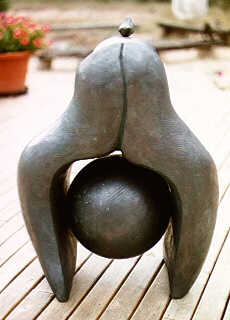

GAIA
goddess of the earth
Joan Relke
Bronze 70cm high 50 cm wide
Gaia or Ge was the ancient Greek earth goddess. As mother of the gods, she was prima creatrix. In one myth, she sprung, unaided, from Chaos and first brought forth Uranus, who became her partner. Together they created the 12 Titans.
gaia and the titans
The Titans deified natural forces, such as thunder, lighning, time, as well as non-human and primal entities, such as the Hecatonchires, each with a hundred hands and fifty heads. From "Titan" we get the word "titanic", which means of giant size and strength. The Titans were formidible.

The most important Titans were Cronus (Time) and Rhea (another Earth Goddess). Together Cronus and Rhea gave birth to the recognisable Greek deities, Zeus, Hera, Demeter, Hestia, Hades, and Poseidon. All but Zeus were later devoured by their father, Cronus.
gaia and zeus
Zeus, as we know him, is a recent import to Greek mythology compared to Gaia. He arrived around 2000 BCE with the Indo-Europeans, and although he might have had another name, no doubt he was the Indo-European sky god of thunder, lightning, and storms. Gaia is a much older goddess, having her roots in the prehistoric Neolithic cultures of the region we now know as Greece and perhaps beyond.
the gaia hypothesis
My Gaia both laments and rejoices in giving birth to the earth and protecting it from harm. She is inspired by the writing of James Lovelock, a chemist, who in 1972, formulated The Gaia Hypothesis, describing his theory in a book of the same name.
The earth, he postulated, is a self-regulating, closed system. Life creates its own environment and thus regulates the climate and all aspects of the ecosystem in which it thrives. Human beings are not independent from their environment. As a life form, we have evolved on earth, been created from the components of our ecosystem, and in turn we create the natural world in which we live and prosper. Upset that balance of our environment, and we can no longer survive as an integral part of it.
 |
Lovelock went further to say that any creature who upsets the symbiotic relationship it has with Gaia calls down upon itself the self-regulating function in which Gaia rids herself of such irritants. No wonder she laments the fate of some of her own creatures, destroyed by time and their own ignorance. |
| Return to Bronze
Goddess Index
|
 |
3/08/09 jr